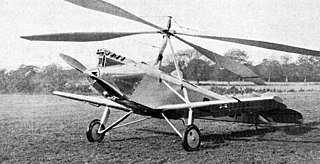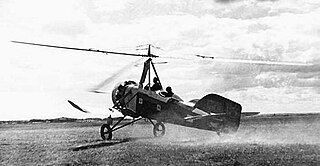
An autogyro, or gyroplane, is a class of rotorcraft that uses an unpowered rotor in free autorotation to develop lift. While similar to a helicopter rotor in appearance, the autogyro's unpowered rotor disc must have air flowing upward across it to make it rotate.

The Cierva C.30 is an autogyro designed by Juan de la Cierva and built under licence from the Cierva Autogiro Company by A V Roe & Co Ltd (Avro), Lioré-et-Olivier and Focke-Wulf.

The Pitcairn OP-1 was the first rotary-wing aircraft to be seriously evaluated by any of the world's major air forces. The machine was not a helicopter, nor an airplane, but an autogyro. Pitcairn's model was never put into production for any military.

The Cierva W.11 Air Horse was a helicopter developed by the Cierva Autogiro Company in the United Kingdom during the mid-1940s. The largest helicopter in the world at the time of its debut, the Air Horse was unusual for using three rotors mounted on outriggers, and driven by a single engine mounted inside the fuselage.

The Fairey FB-1 Gyrodyne is an experimental British rotorcraft that used single lifting rotor and a tractor propeller mounted on the tip of the starboard stub wing to provide both propulsion and anti-torque reaction.

The Cierva C.8 was an experimental autogyro built by Juan de la Cierva in England in 1926 in association with Avro. Like Cierva's earlier autogyros, the C.8s were based on existing fixed-wing aircraft fuselages – in this case, the Avro 552.

The Cierva C.17 was a British experimental autogyro built by Cierva Autogiro Company in England in 1928, in association with Avro. It was an attempt to build upon the successful Cierva C.8 design using the smaller, more streamlined fuselage of an Avro Avian IIIA as a starting point. The type was found to be underpowered, and when the first attempt at fitting a more powerful engine still did not result in acceptable performance, the design was abandoned.

The Cierva C.19 was a 1930s British two-seat autogyro, designed by Spanish engineer Juan de la Cierva. It was built by Avro as the Avro Type 620. It proved to be the most successful and widely produced of the early de la Cierva designs.

The Kellett KD-1 was a 1930s American autogyro built by the Kellett Autogiro Company. It had the distinction of being the first practical rotary-wing aircraft used by the United States Army and inaugurated the first scheduled air-mail service using a rotary-wing aircraft.

The Kellett K-2 was a two-seat autogyro developed in the United States in the early 1930s. Later examples were designated K-3 and K-4 when equipped with more powerful engines. K-3 NC 12691 is seen in the 1934 movie, It Happened One Night.

The de Havilland C.24 was a two-seat autogyro built by de Havilland at its Stag Lane works in England in 1931

The Pitcairn PAA-1 was an autogyro developed in the United States in the early 1930s. Of similar configuration to Pitcairn's earlier machines, the PAA-1 had an airplane-like fuselage with two open cockpits in tandem and a tractor-mounted engine in the nose. It was also equipped with small wings, which carried control surfaces, rather than using the rotor for flight control. It was a smaller and lighter machine than its predecessors and was designed specifically with private pilots in mind.

The Pitcairn PA-18 was an autogyro produced in the United States in the early 1930s.
The Pitcairn PA-19 was a four-seat autogyro developed in the United States in the early 1930s. While most of Pitcairn's autogyro designs featured open cockpits in tandem, the PA-19 had a fully enclosed cabin. It also had wings that carried control surfaces. The rotor provided lift only, but could be tilted in flight to trim the aircraft. Four examples were built before the effects of the Great Depression forced Pitcairn to abandon autogyro production in 1934.

The Pitcairn PCA-2 was an autogyro developed in the United States in the early 1930s. It was Harold F. Pitcairn's first autogyro design to be sold in quantity. It had a conventional design for its day – an airplane-like fuselage with two open cockpits in tandem, and an engine mounted tractor-fashion in the nose. The lift by the four-blade main rotor was augmented by stubby, low-set monoplane wings that also carried the control surfaces. The wingtips featured considerable dihedral that acted as winglets for added stability.

The Autogiro Company of America AC-35 was an early attempt to make a roadable aircraft in the United States during the 1930s. Although it was successfully tested, it did not enter production; a 1960s attempt to revive the aircraft in a non-roadable version also failed to achieve success.

The Trixy G 4-2 R is an Austrian autogyro, designed and produced by Trixy Aviation Products of Dornbirn. The aircraft was introduced at the Aero show held in Friedrichshafen in 2011 and when it was available it was supplied as a complete ready-to-fly-aircraft.
The Westland CL.20 was a two-seat autogyro designed and built by Westland Aircraft between 1934 and 1938. One flying prototype and six airframes were built, which had control problems and insufficient lift. Before these problems could be solved the programme was abandoned and the prototype was scrapped in 1938.

The TsAGI A-4, sometimes anglicised as CAHI A-4 or ZAGI A-4, was an early Russian autogyro, influenced by Cierva designs and delivered in small numbers to the Soviet Air Force in 1934.

The 1933 experimental Pitcairn PA-22 was one of the first wingless autogyros. It was controlled by movement of the rotor plane rather than the usual control surfaces, though initially the much modified lone example retained rudders as a precaution.


















